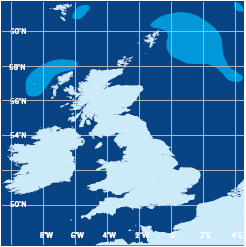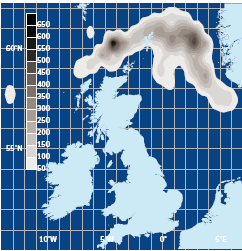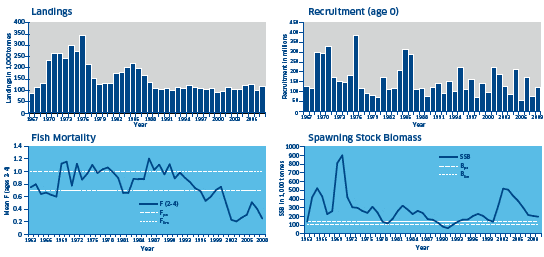Introduction

Like most fish, they vary in abundance throughout the year but can be caught all year round as part of a mixed fishery.
The main fishery takes place in the northern North Sea and on the shelf edge to the west and north-west of Scotland. Traditionally this fishery has mainly been operated by the larger deep sea french trawlers but the number of these vessels has declined in recent years. Currently, less than one tenth of the total landings of saithe come from the west coast area.
Each year, the quantity of saithe in the sea depends on the numbers of juvenile fish which survive from spawning to enter the adult fishery as recruits. The numbers of saithe capable of spawning remain at or close to the lowest recorded levels at present. The stock is depleted to such a low level that recruitment has been affected. This situation and the large year to year variation in the survival rates of young fish means that management controls are necessary for the survival of this stock.

Biology
Adult saithe can be caught in almost any sea area but occur mainly around the 200m depth contour. In late summer and autumn young saithe are found in large numbers within Scottish and Norwegian coastal waters, usually on grounds which are unsuitable for commercial fishing. The adult stock can occur in dense shoals which move around the water column and are often caught hundreds of metres above the seabed.

Saithe reach maturity between the ages of four and six years. A medium sized adult female can produce about 2.5 million eggs during a spawning season. Spawning takes place between January and April near to the edge of the continental shelf to the north and west of the outer hebrides. Initially the young fish live near to the surface but by mid-summer they can be found close inshore, in bays and harbours. In their second year they live along the shoreline before eventually moving to deeper water. This offshore migration usually occurs in springtime. Saithe grow quickly, averaging around 15cm per year for the first three years and 10cm for the next three, reaching 100cm by the time they are eleven years old.
Saithe are active predators, feeding on the bottom and in mid-water. By weight, fish prey dominate their diet at all times of the year. herring, Norway pout and sandeel are the main fish species eaten.
ICES Advice on Management

Summary
- Stocks are being harvested sustainably
- Landings for the last seven years have been lower than the TAC
- Fishing mortality has been below Fpa since 1997
Precautionary approach reference points
For this stock, ICES has proposed that the precautionary level for stock biomass (Bpa) be set at 200,000 tonnes, and the precautionary level for fishing mortality (Fpa) be set at 0.4. The limit reference point for spawning stock biomass (Blim) is 106,000 tonnes, and limit reference point for fishing mortality (Flim) is 0.6.
State of stock
Based on the most recent estimates of spawning stock biomass (in 2009) and fishing mortality (in 2008), ICES classifies the stock as having full reproductive capacity and being harvested sustainably. SSB is estimated to have been above Bpa since 2001. From 2001 onwards, F has been at or below the target fishing mortality of 0.3.
Management advice
The agreed EU–Norway management plan sets out to maintain the SSB above 106,000 tonnes, and restrict the rate of exploitation to no higher than F = 0.3 when the stock is above Bpa.
The management plan was evaluated by ICES in 2008 and was considered to be consistent with the precautionary approach in the short term (less than five years).
At the present SSB level an F of no more than 0.3 would give a 24 per cent reduction in the TAC. however, there is a 15 per cent TAC constraint when the stock is above Bpa ICES advises on the basis of the agreed management plan that the constraint be applied. This corresponds to landings of 118,000 t in 2010. This advice applies to saithe in division IIIa and Sub areas IV and VI.
Following the management plan should provide an appropriate response to the natural fluctuations that are occurring in recruitment that will cause the reduction in SSB to around Bpa over the next few years.
Information from fishers indicates that reported landings have been lower than the TAC because of low market prices for saithe combined with high fuel prices. There are also claims that the abundance of saithe has been reduced in recent years.
Compared to last years assessment, SSB in 2008 has been revised downwards by 14 per cent and F in 2007 has been revised upwards by 6 per cent. Recruitment in 2007 has been estimated 21 per cent lower in this years assessment. The basis of the advice is unchanged.
Management action
At the December 2009 meeting in Brussels, the Council of Ministers decided that the EU Total Allowable Catch for North Sea and west of Scotland saithe should be 61,537 tonnes. The UK quota for 2010 was set at 11,878 tonnes.
May 2010

